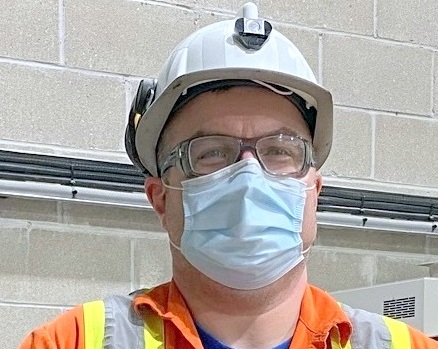
Follow your heat stress prevention plan with a few new considerations for the pandemic
As summer temperatures climb and many workers are performing their job duties while wearing masks, it's crucial for employers to keep heat safety top of mind.
Our advice? Continue to follow a heat stress prevention plan, with a few new considerations.
“It’s important to plan for all the potential risks that workers face,” says Keith Birnie, Industrial Hygiene and Ventilation Specialist at Workplace Safety North. “For most workplaces, heat stress and heat-related illnesses is a concern, especially with new requirements around personal protective equipment during the pandemic.”
Here are tips for keeping workers safe this summer.
1. Assess the risks
Whether employees are in the field, at a hot stove, or on a construction site, heat exposure could have a significant impact on their health and safety.
One way to evaluate the risk is by calculating the humidex rating, which is a single value that accounts for both temperature and humidity. The humidex rating is a better measure than air temperature alone for estimating the risk to workers from environmental heat sources. Another method to evaluate the risk is determining the Wet Bulb Globe Temperature (WBGT) index, which closely relates to the human body’s response to heat, and takes into account air temperature, air movement, radiant heat and humidity. The Canadian Centre for Occupational Safety and Health lists exposure limits for heat stress, with a correction listing based on type of clothing.
Some other factors to consider, according to OSHA and the National Institute for Occupational Safety and Health (NIOSH), are:
- Direct sunlight with limited access to shade
- Exposure to indoor sources of radiant heat (like a stove or furnace)
- Limited air circulation
- Low fluid consumption
- Physical exertion
- Heavy personal protective equipment (PPE)
Other considerations include:
- Poor physical condition or health problems
- Advanced age and the use of medications
- Fogging of glasses associated with high heat environments
2. Face masks and heat stress
Current guidelines require many workers to wear masks to prevent transmission of COVID-19. While workers in some industries may be used to wearing masks in warm environments, it is new for others. Depending on the work environment, wearing a mask could increase breathing resistance and heat load, increasing the wearer’s risk of heat stress.
“Managing COVID-19 and heat stress prevention programs at the same time is a challenge,” says Birnie. “Conduct a proper risk assessment and ensure policies and procedures are in place to keep employees safe. Spring is the ideal time to communicate to workers as they will be getting acclimated to warmer temperatures, and expectations around safety will help them prepare for the hotter days of summer.”
3. Protect the worker
The most effective way to prevent heat-related injuries or illnesses is to minimize or eliminate the risk altogether. One way to do this is to change shift schedules or working times so that workers are not outside during the hottest time of day.
Hazard elimination is not always possible, however. When employees must be exposed to high temperatures or sources of heat, it’s important to provide them with the necessary resources, breaks, and PPE. Consider developing an acclimatization plan to help workers adapt to hot environments, including proper rehydration schedules. Also, ensure proper fitting and donning of mask to help prevent fogging of safety glasses.
According to the Center for Disease Control and Prevention (CDC), if workers are in an environment where cloth face coverings may increase the risk of heat-related illness or cause safety concerns, consult with an occupational safety and health professional to identify the right face covering for the job.
Many organizations post a urine colour chart in their washrooms to help raise awareness about the need to hydrate during hotter temperatures.
If face coverings can’t be used, it’s important to use other measures to prevent transmission of COVID-19, including physical distancing, frequent hand washing, and cleaning and disinfecting frequently touched surfaces.
4. Learn the symptoms
No matter how much you prepare, illness may still occur. Learning the signs and symptoms of different levels of heat stress could save a life.
This handout makes a side-by-side comparison of two common heat illnesses-heat stroke and heat exhaustion-and outlines the appropriate responses for each.
Keep in mind that some COVID-19 symptoms are similar to heat-related illness. If you or a worker are experiencing such symptoms, stop working and seek the appropriate medical care.
For more information on heat stress, visit WSN heat stress resources.
Article based on “How to avoid heat stress for masked workers” by SAIF organization.
Related
How to manage heat stress in the workplace; includes safety talks and awareness guide - WSN
COVID-19 and workplace health and safety - MLTSD
Free Resources
Free heat stress prevention resources - Workplace Safety North
Heat Stress Awareness Guide - Occupational Health and Safety Council of Ontario
Heat stress guideline – Ontario Ministry of Labour, Training and Skills Development
Humidex Calculator - Occupational Health Clinic for Ontario Workers
Managing and preventing heat stress in the workplace - Health and safety conference presentation
Mining safety report with new heat stress standard released in Ontario
Sun safety in Canada infographic - Canadian Centre for Occupational Health and Safety (CCOHS)
Urine colour chart to assess hydration
Working in the Heat infographic - CCOHS
